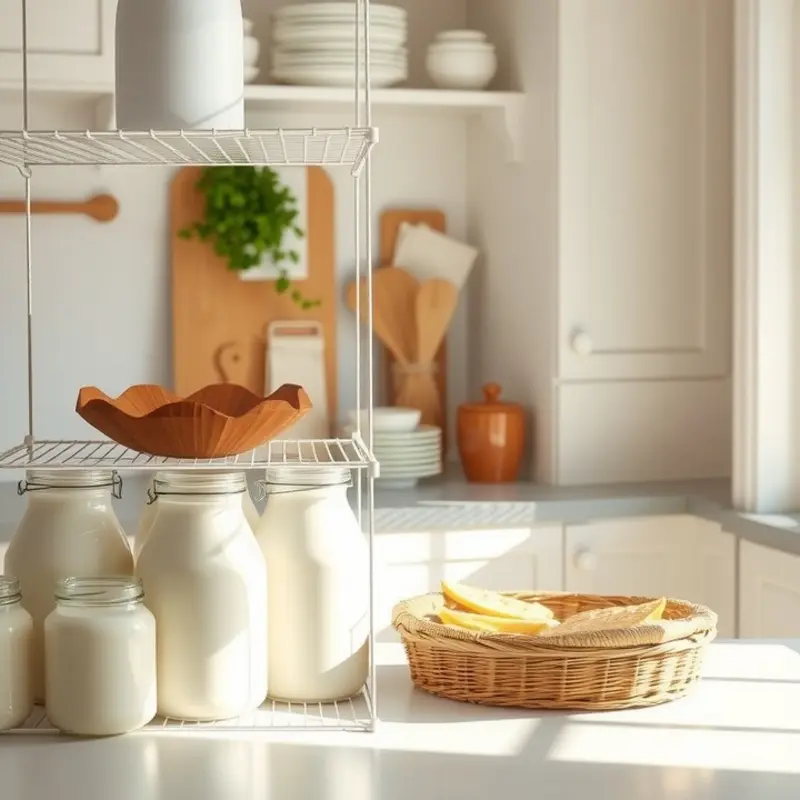Powdered milk is a versatile ingredient that can be a staple in many households due to its long shelf-life and convenience. However, understanding how to properly store it and maximize its lifespan is crucial for food management at home. With the right techniques, you can prevent waste, ensuring that your powdered milk remains fresh and ready for use whenever you need it. Let’s explore practical storage methods and tips to keep your powdered milk in optimal condition.
Understanding Powdered Milk Shelf-Life

The shelf-life of powdered milk is influenced by multiple factors, starting with its type. There are generally two categories: whole milk powder and non-fat dry milk. Whole milk powder, due to its fat content, has a shorter shelf-life compared to non-fat variants. This is because fats can oxidize over time, leading to rancidity. In contrast, non-fat dry milk can last longer, sometimes up to 25 years under optimal conditions.
Expiration dates provided by manufacturers are great guidelines for safety and quality, yet they are not absolute. “Best by” dates typically indicate when the product remains at peak quality, but powdered milk often remains usable beyond this period if stored correctly. A vital aspect to consider is whether the package is opened or unopened. Unopened packages are sealed from external contaminants, enabling them to maintain their freshness much longer than opened ones.
Proper storage is crucial for maximizing the shelf-life of powdered milk. The primary enemies are air, moisture, light, and heat. Storing powdered milk in an airtight container prevents exposure to air and moisture. A cool, dry place, away from direct sunlight, is ideal for storage. Temperatures below 75°F (24°C) are recommended, as higher temperatures accelerate the degradation process.
Once a package is opened, the timeline changes significantly. Exposure to air can lead to moisture pick-up and flavor loss. Storing the powder in a vacuum-sealed or airtight container helps maintain its quality. An effective method to ensure freshness is the use of oxygen absorbers inside the storage container to help decrease oxidation and extend shelf-life.
Determining whether powdered milk is still fresh involves a few steps. Observe its appearance first; discoloration or clumping may indicate spoilage. Next, smell the powder. Rancid or off aromas are a clear sign the product should no longer be used. Finally, a small taste test can confirm its current condition. Any off-flavor suggests that it is past its prime.
For those interested in broader advice on storing various food products to reduce waste, this eco-smart kitchen storage guide offers valuable insights on minimizing food spoilage by adopting efficient storage practices.
Understanding the unique requirements of powdered milk and adopting these storage tips can significantly reduce wastage, ensuring you always have fresh and safe milk powder available when needed.
Best Practices for Storing Powdered Milk

Powdered milk is a kitchen staple that, when stored correctly, can maintain its quality for an extended period, minimizing waste and saving costs. The first step in prolonging the shelf-life of powdered milk is choosing the right container. Opt for opaque, airtight containers to block out light and air, two factors that accelerate spoilage. Glass jars with tight-fitting lids, or high-quality plastic containers with rubber seals, can be excellent choices.
Once you have the right container, ensure it remains airtight. This is crucial because exposure to air can lead to oxidation and off-flavors. Regularly check the seals of your storage containers, especially if they endure frequent opening and closing.
Storage location plays a significant role in preserving powdered milk. Keep the containers in a cool, dry place, away from direct sunlight. A dark pantry or a kitchen cupboard far from heat sources like ovens or stoves is ideal. Avoid places where temperature fluctuates greatly, as these can lead to condensation inside the container and eventual spoilage.
The ideal storage temperature for powdered milk is between 50°F and 60°F (10°C-15°C). Storing it in an overly warm environment can degrade its nutritional quality and flavor quickly. If you live in an area with a warm climate and lack the necessary storage conditions, consider refrigeration. This can extend shelf life, but always ensure the milk is in a sealed container to prevent moisture absorption.
Generally, powdered milk remains usable for up to 18 months when stored in optimal conditions, but always check for signs of spoilage. Before use, look for any changes in the product’s appearance, such as clumping, a change in color, or an off-putting smell. These are indications that the milk might be compromised and unsuitable for consumption.
Maximizing usability involves more than just proper storage. Incorporate a first-in, first-out approach, using older stocks before opening new ones. This practice reduces the risk of accidentally using expired milk. Label containers with the date of purchase to keep track of age effortlessly.
For those keen on reducing waste further, consider exploring techniques in eco-smart kitchen storage. These practices provide deeper insights into sustainable storage that benefits both you and the environment.
Careful attention to these best practices ensures your powdered milk retains its quality for the longest possible time, allowing you to enjoy its versatility and nutritional benefits without unnecessary waste.
Final words
Proper storage techniques for powdered milk can significantly enhance its shelf-life, helping reduce waste and improve food management within your household. By understanding the factors affecting its longevity and adopting best practices for storage, you will ensure that your powdered milk remains fresh and ready to use. Always keep track of expiration dates and check for signs of spoilage, so you can enjoy this versatile ingredient when needed. Implementing these strategies allows you to minimize waste and maintain a well-organized pantry, making cooking at home both easier and more sustainable.







